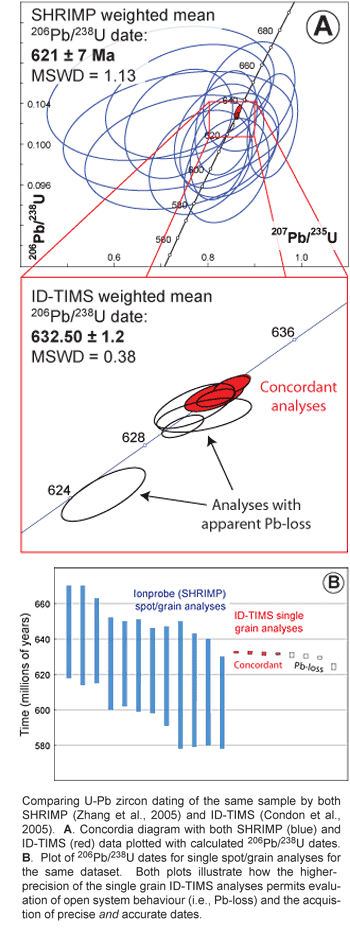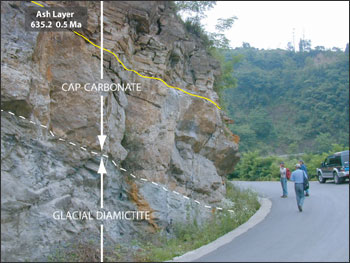by Sam Bowring & Dan Condon
Understanding the details of Neoproterozoic climate fluctuations and
links with biological evolution center around our ability to precisely
correlate
and sequence disparate stratigraphic sections. Relative ages of events
can be established within single sections or by regional correlation using
litho-, chemo- and/or biostratigraphic markers. However, such chronologies
do not allow testing of the synchroneity of units, the validity of correlations
or determining rates of change/duration of events. At present, the major
limitation to our understanding of the Neoproterozoic, and the number
and duration of “snowball” glaciations, is
the dearth of high-precision dates. However, the increase in geochronological
constraints over the past five years indicates that progress is possible.
Techniques

The determination of 'absolute'
age constraints for Neoproterozoic successions can be achieved using a
variety
of geochronological techniques.
These include whole rock approaches using Re-Os, Pb-Pb and Lu-Hf decay
schemes as well as U-Pb dating of zircon from volcanic rocks to directly
date the horizon sampled, and detrital zircon to constrain the maximum
depositional age. While the database of geochronological constraints for
the Neoproterozoic is growing the data are of variable precision and accuracy
and typically subject to multiple assumptions and interpretations. For
example, whole rock dates depend on the assumptions that a suite of samples
all
have the
same
initial isotopic ratios and evolved through time only as a function
of different parent/daughter ratios. In the
cases of Pb-Pb, U-Pb and Lu-Hf dating, calculated
dates are interpreted to reflect either primary precipitation or the time
of early diagenesis/fluid flow of carbonate and phosphate (Pb-Pb, Lu-Hf)
or enrichment of parent isotope during deposition/early diagenesis (Re-Os).
These assumptions are difficult to evaluate in many cases and it is possible
to produce statistically significant linear arrays on isotope correlation
diagrams that are mixing lines and have no geological significance (e.g.
Schaeffer and Burgess). However, new developments in Re-Os dating of black
shales show considerable promise. U-Pb geochronology data are derived from
Isotope Dilution Thermal Ionization Mass-Spectrometry (ID-TIMS), ion-probes
(SHRIMP, Cameca 1270-1280’s), and Laser Ablation Inductively Coupled
Mass Spectrometry (LA-ICPMS) and there are important differences between
these techniques. While it is tempting to use all available geochronological
data in compilations irrespective of decay scheme and precision, caution
is urged.
The ID-TIMS approach can yield single grain U-Pb dates with a precision
of better than about 0.1 percent; however, it is a time consuming and expensive
approach. In contrast, ion-probe single spot analyses have typical analytical
uncertainties of about 2-5 percent and are reliant upon the pooling of
datasets with lots of samples in order to calculate dates with uncertainties
of about 1 percent. Although
in-situ
analyses afford high-spatial resolution combined with rapid throughput
of analyses, the low precision of a single analysis does not permit identification
of the subtle effects of Pb-loss/inheritance (see Figure above). In
the end, high precision dates are required to test synchroneity/diachroneity
of
glacial deposits.
What do we know?
Considerable progress has been made in the past decade on the calibration
of Neoproterozoic time. Although the number, timing, duration and possible
synchroneity of ‘Cryogenian’ glacial episodes still remains
poorly constrained, there is growing evidence for at least two glacial-cap
carbonate sequences during the 760 to 700 Ma interval, one at about 635
Ma, and a final one at about 582 Ma.

The
base of the Ediacaran period is formally defined at the base of the Nuccaleena
(Marinoan) cap-carbonate as exposed
in Enorama Creek, Flinders Ranges, South Australia. Correlation of its
distinctive cap sequence coupled with high–precision U-Pb (zircon)
ages from Namibia (within the glacial Ghaub Formation) and Southern China
(within the cap carbonate to the Nantuo tillite) indicate synchronous termination
of the Marinoan glaciation at about 635 Ma (See photo). The top of the
Ediacaran Period/base Cambrian Period is not dated at its type locality.
However
U-Pb zircon dates on ash beds from Oman and Namibia constrain it to be
about 542 Ma. During the Ediacaran Period the short-lived Gaskiers glaciation
occurred about at 582 Ma and the oldest known Ediacaran fossils first appear
within 4 Ma of deglaciation. When all well-dated sequences containing Ediacaran
fossils are considered in the context of global chemostratigraphic correlation
schemes, a number of major conclusions can be drawn. At about 560-551 Ma,
the global carbon cycle underwent a major reorganization consistent with
progressive oxidation and remineralization of the organic reservoir. At
about same time, and suggestive of a link, the first complex trace fossils
as well as the stem group mollusc,
Kimberella, are found in White
Sea sections. Weakly calcified metazoans, such as
Cloudina and
Namacalathus appear
at about 548 Ma and continue to the Ediacaran/Cambrian boundary where they
are inferred to have become extinct. It is clear that our understanding
of
the relationships/feedback
loops between biology, the carbon cycle, and climate will require a much
more highly calibrated record.
Issues
Outstanding issues center on the number, synchroneity and durations of
glacial deposits, the exact age of the spectacular animal embryos preserved
in the Doushantou Formation of southern China, the cause of large δ
13C
excursions that are seemingly unrelated to glaciation, the validity of
molecular clock estimates for the timing of animal evolution, and the global
significance
of the
Gaskiers
glacial
event
and the first appearance of megascopic Ediacaran fossils. At present the
age of the only glacial deposits to yield unequivocal equatorial paleolatitudes,
the Elatena, is unknown but the rocks have been correlated with dated rocs
that are as old as 635 Ma and as young as 580 Ma. Future work will focus
on using the highly calibrated record to understand developmental and environmental
controls on evolution that preceded the Cambrian explosion, including a
precise and accurate temporal framework for the period from about 1000
Ma until 750 Ma in order to integrate proxy records (isotopic, lithostratigraphic
and
paleomagnetic) with evaluated causal relationships and rate-dependent effects
responsible for the transition into the Cryogenian.
Selected References
Amthor, J. E., Grotzinger, J. P., Schroder, S., Bowring, S. A., Ramezani, J., Martin, M. W., and Matter, A., 2003, Extinction of
Cloudina and
Namacalathus at the Precambrian-Cambrian boundary in Oman: Geology, v. 31, p. 431-434.
Barfod, G. H., Albarede, F., Knoll, A. H., Xiao, S. H., Telouk, P., Frei, R., and Baker, J., 2002, New Lu-Hf and Pb-Pb age constraints on the earliest animal fossils: Earth And Planetary Science Letters, v. 201, p. 203-212.
Bowring, S. A., and Schmitz, M. D., 2003, High-precision U-Pb zircon geochronology
and the stratigraphic record: Zircon, v. 53, p. 305-326.
Bowring, S., Myrow, P., Landing, E., and Ramezani, J., 2003, Geochronological constraints on terminal Neoproterozoic events and the rise of metazoans: Geophysical Research Abstracts, v. 5, p. 219.
Brasier, M., McCarron, G., Tucker, R., Leather, J., Allen, P., and Shields, G., 2000, New U-Pb zircon dates for the Neoproterozoic Ghubrah glaciation and for the top of the Huqf Supergroup, Oman: Geology, v. 28, p. 175-178.
Calver, C. R., Black, L. P., Everard, J. L., and Seymour, D. B., 2004, U-Pb zircon age constraints on late Neoproterozoic glaciation in Tasmania: Geology, v. 32, p. 893-896.
Chu, X. L., Todt, W., Zhang, Q. R., Chen, F. K., and Huang, J., 2005, U-Pb zircon age for the Nanhua-Sinian boundary: Chinese Science Bulletin, v. 50, p. 716-718.
Condon, D., Zhu, M. Y., Bowring, S., Wang, W., Yang, A. H., and Jin, Y. G., 2005, U-Pb ages from the neoproterozoic Doushantuo Formation, China: Science, v. 308, p. 95-98.
Evans, D. A. D., 2000, Stratigraphic, geochronological, and paleomagnetic constraints upon the Neoproterozoic climatic paradox: American Journal Of Science, v. 300, p. 347-433.
Fanning, C. M., and Link, P. K., 2004, U-Pb SHRIMP ages of Neoproterozoic (Sturtian) glaciogenic Pocatello Formation, southeastern Idaho: Geology, v. 32, p. 881-884.
Halverson, G. P., Hoffman, P. F., Schrag, D. P., Maloof, A. C., and Rice, A.
H. N., 2005, Toward a Neoproterozoic composite carbon-isotope record: Geological
Society Of America Bulletin, v. 117, p. 1181-1207.
Hoffman, P. F., Hawkins, D. P., Isachsen, C. E., and Bowring, S. A., 1996, Precise U-Pb zircon ages for early Damaran magmatism in the Summas Mountains and Welwischia Inlier, northern Damara Belt, Namibia: Communications of the Geological Survey of Namibia, v. 11, p. 21-31.
Hoffmann, K.-H., Condon, D. J., Bowring, S. A., and Crowley, J. L., 2004, U-Pb zircon date from the Neoproterozoic Ghaub Formation, Namibia: Constraints on Marinoan glaciation: Geology, v. 32, p. 817-820.
Kendall, B. S., Creaser, R. A., Ross, G. M., and Selby, D., 2004, Constraints on the timing of Marinoan "Snowball Earth" glaciation by Re-187-Os-187 dating of a Neoproterozoic, post-glacial black shale in Western Canada: Earth And Planetary Science Letters, v. 222, p. 729-740.
Martin, M. W., Grazhdankin, D. V., Bowring, S. A., Evans, D. A. D., Fedonkin, M. A., and Kirschvink, J. L., 2000, Age of Neoproterozoic bilatarian body and trace fossils, White Sea, Russia: Implications for metazoan evolution: Science, v. 288, p. 841-845.
Yin, C., Tang, F., Liu, Y., Gao, L., Liu, P., Xing, Y., Yang, Z., Wan, Y., and
Wang, Z., 2005. U-Pb zircon age from the base of the Ediacaran Doushantuo Formation
in the Yangtze Gorges, South China: constraint on the age of Marinoan glaciation.
Episodes 28, 48-49.
Zhang, S. H., Jiang, G. Q., Zhang, J. M., Song, B., Kennedy, M. J., and Christie-Blick, N., 2005, U-Pb sensitive high-resolution ion microprobe ages from the Doushantuo Formation in south China: Constraints on late Neoproterozoic glaciations: Geology, v. 33, p. 473-476.
Zhou, C. M., Tucker, R., Xiao, S. H., Peng, Z. X., Yuan, X. L., and Chen, Z., 2004, New constraints on the ages of neoproterozoic glaciations in south China: Geology, v. 32, p. 437-440.
Sam Bowring is a professor at Massachusetts Institute of Technology and
Dan Condon
is with the NERC Isotope Laboratory at the British Geological Survey. Both laboratories are partipating in
EARTHTIME, the international scientific initiative to calibrate geological time to one tenth of one percent.